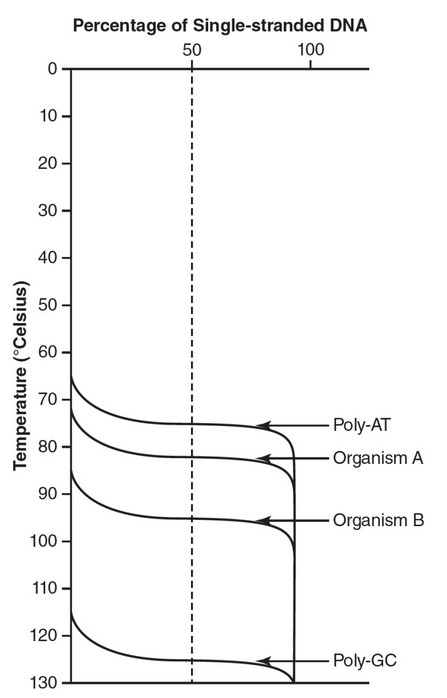Question
The melting temperature (Tm) is defined as the temperature at which
50% of double-stranded DNA is separated into single-stranded DNA.
The greater the guanine-cytosine (poly-GC) of the DNA, the higher the
Tm compared to DNA with more adenine-thymine (poly-AT) content.
The following graph shows the Tm of a poly-AT DNA strand, a poly-
GC DNA strand, and DNA from two different organisms (A and B).
(a) Describe how the Tm of DNA from organism A compares to the
Tm of DNA from organism B.
(b) Describe the differences between the Tm of poly-AT and the Tm
of poly-GC DNA.
(c) DNA sequencing finds that DNA from organism A has a GC
content of 39% and that DNA from organism B has a GC content
of 48%. A student claims that DNA from organism C (with a GC
content of 55%) would have a Tm greater than 85° Celsius. Using
the data from the figure, evaluate the student’s claim.
(d) Explain how these experimental results relate to the structure of
DNA.
▶️Answer/Explanation
Ans:
(a) The Tm of DNA from organism A is lower than the Tm of DNA
from organism B.
(b) The Tm of poly-GC DNA is much higher than the Tm of poly-AT
DNA.
(c) DNA from organism B has a GC content of 48% and a Tm of
approximately 85° Celsius. Since increased GC content leads to a
higher Tm and the DNA from organism C has a GC content of
55%, it would follow the pattern of the data that organism C’s Tm
would be higher than 85° Celsius.
(d) In DNA, GC pairs form three hydrogen bonds while AT pairs form
only two hydrogen bonds. More hydrogen bonds would require
more energy to separate, so it makes sense that DNA with a higher
GC content would have a higher Tm.
Question
The melting temperature (Tm) is defined as the temperature at which
50% of double-stranded DNA is separated into single-stranded DNA.
The greater the guanine-cytosine (poly-GC) of the DNA, the higher the
Tm compared to DNA with more adenine-thymine (poly-AT) content.
The following graph shows the Tm of a poly-AT DNA strand, a poly-
GC DNA strand, and DNA from two different organisms (A and B).
(a) Describe how the Tm of DNA from organism A compares to the
Tm of DNA from organism B.
(b) Describe the differences between the Tm of poly-AT and the Tm
of poly-GC DNA.
(c) DNA sequencing finds that DNA from organism A has a GC
content of 39% and that DNA from organism B has a GC content
of 48%. A student claims that DNA from organism C (with a GC
content of 55%) would have a Tm greater than 85° Celsius. Using
the data from the figure, evaluate the student’s claim.
(d) Explain how these experimental results relate to the structure of
DNA.
▶️Answer/Explanation
Ans:
(a) The Tm of DNA from organism A is lower than the Tm of DNA
from organism B.
(b) The Tm of poly-GC DNA is much higher than the Tm of poly-AT
DNA.
(c) DNA from organism B has a GC content of 48% and a Tm of
approximately 85° Celsius. Since increased GC content leads to a
higher Tm and the DNA from organism C has a GC content of
55%, it would follow the pattern of the data that organism C’s Tm
would be higher than 85° Celsius.
(d) In DNA, GC pairs form three hydrogen bonds while AT pairs form
only two hydrogen bonds. More hydrogen bonds would require
more energy to separate, so it makes sense that DNA with a higher
GC content would have a higher Tm.
Question
Genomes with a higher GC content are more likely to resist
denaturation. A plant biologist hypothesized that plants with a higher
GC content in their genomes are more likely to be found in colder
climates. Four species of plants were examined for the percentage of
GC content in their genomes. Brachypodium pinnatum and Dioscorea
caucasica are native to areas with cold winters. Juncus inflexus and
Carex acutiformis are native to areas with warmer winters. DNA was
examined from 50 plants of each species. Results are shown in the
table.
| Plant Species | Mean Percent of GC Content | Standard Error of the Mean |
| Brachypodium pinnatum | 46.0 | 1.9 |
| Dioscorea caucasica | 42.5 | 2.0 |
| Juncus inflexus | 33.7 | 2.0 |
| Carex acutiformis | 35.6 | 0.8 |
(a) Using what you know about DNA structure, explain why
genomes with a higher GC content might be more stable than
genomes with a lower GC content.
(b) On the axes provided, construct an appropriately labeled graph of
the mean percent of GC content in each species’s genome. Include
95% confidence intervals.
(c) Do the data support the claim that plants in colder climates have a
higher GC content in their genomes? Use the data provided to
support your answer.
(d) A plant species has a genome with a GC content of 43.4%.
Predict whether that plant is more likely to be native to an area
with cold winters or an area with warmer winters. Justify your
prediction.
▶️Answer/Explanation
Ans:
(a) The two strands of a DNA double helix are held together by
hydrogen bonds between the base pairs. AT pairs form two
hydrogen bonds, and the GC pairs form three hydrogen bonds.
Since GC pairs form more hydrogen bonds, that may make DNA
with a higher GC content more stable across a wider range of
temperatures than DNA with a lower GC content.
(b) 
(c) Yes, the claim that plants in colder climates have a higher GC
content in their genomes is supported by the data. B. pinnatum and
D. caucasica are native to colder climates. Both also have
statistically significantly higher GC content in their genomes as
compared to the species found in warmer winter locations (J.
inflexus and C. acutiformis), as shown in the graph for part (b).
(d) The plant with a GC content of 43.4% is more likely be native to an
area with cold winters since its GC content is closer to the GC
contents found in B. pinnatum and D. caucasica.
